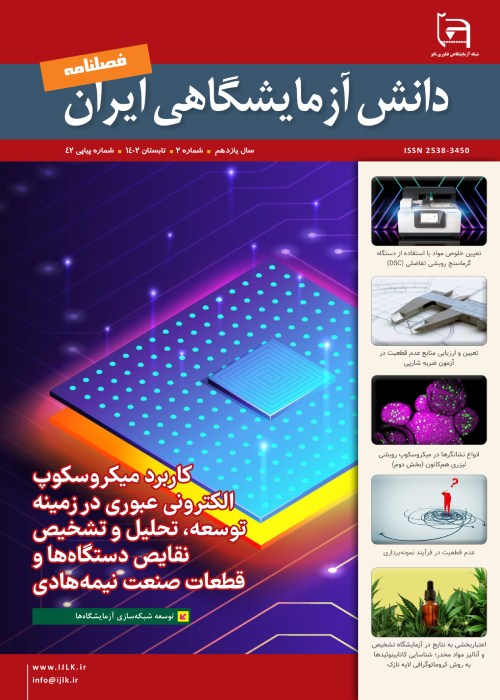فهرست مطالب

مجله دانش آزمایشگاهی ایران
پیاپی 42 (تابستان 1402)
- تاریخ انتشار: 1402/06/28
- تعداد عناوین: 8
-
صفحات 2-5
- استاندارد
- مقالات
-
صفحات 8-12
-
صفحات 25-31
-
Pages 8-12
Uncertainty in the sampling process is an important challenge in statistical sciences and research studie. in this article, an attempt was made to examine the factors that cause errors and uncertainty in sampling and research, as well as various methods of reducing uncertainty in them.
Keywords: Sampling, uncertainty -
Pages 13-18
There are always some precision and uncertainties in the measurement of the final report, especially if this measurement is done with laboratory equipment. For this purpose, investigating and evaluating the factors that create uncertainty in the final value can always lead to a more accurate value. Therefore, in this research article, the factors and parameters that cause error and uncertainty in the final value in the Charpy impact test, which is a widely used test in measuring the energy absorbed by various materials such as steel in the construction of steel pipes for use in water transmission, gas, and oil are investigated. The uncertainty of the device was calculated along with the uncertainty resulting from the reproducibility. Finally, for a Charpy test device, the numerical results were calculated to the amount energy absorbed 185.2 J with an expanded uncertainty of 4.078 with a confidence factor of 95%, taking into account the degree of freedom of the test. Also, according to the calculations, the share of repeatability uncertainty is more than other uncertainty factors.
Keywords: Uncertainty, Impact test, Charpy, Repeatability, Type A, B uncertainty -
Pages 19-24
The differential calorimetry (DSC) thermal analysis method is used by many researchers for thermal analysis and to investigate the behavior of different materials when faced with temperature changes. While this method has other practical aspects. One of these applications is determining the purity of materials. Which is very important in the preparation of reference materials or the pharmaceutical industry. This article examines the method of determining the purity of materials. It is paid through a calorimeter. Which is cheaper and faster compared to other methods. And it has acceptable accuracy.
Keywords: purity, Thermal analysis, van’t Hoff’sEquation -
Pages 25-31
Part 2Biological laser scanning confocal microscopy relies heavily on fluorescence as an imaging mode, primarily due to the high degree of sensitivity afforded by the technique coupled with the ability to specifically target structural components and dynamic processes in chemically fixed as well as living cells and tissues. Many fluorescent probes are constructed around synthetic aromatic organic chemicals designed to bind with a biological macromolecule (for example, a protein or nucleic acid) or to localize within a specific structural region, such as the cytoskeleton, mitochondria, Golgi apparatus, endoplasmic reticulum, and nucleus. Other probes are employed to monitor dynamic processes and localized environmental variables, including concentrations of inorganic metallic ions, pH, reactive oxygen species, and membrane potential. Fluorescent dyes are also useful in monitoring cellular integrity (live versus dead and apoptosis), endocytosis, exocytosis, membrane fluidity, protein trafficking, signal transduction, and enzymatic activity. In addition, fluorescent probes have been widely applied to genetic.
Keywords: Laser scanning confocal microscopy, Fluorescence, Fluorophores -
Pages 32-40
Thin layer chromatography is a common technique for the separation and identification of drugs. There are several thin layer chromatography methods for the qualitative and semi-quantitative analysis of cannabis, using a variety of stationary and mobile phases, sample preparation methods, and spot Visualization/detection techniques. However, any method that is newly applied in the laboratory should be tested before routine use; Be validated and approved.
Keywords: Validation, cannabinoids, Tetrahydrocannabinol, Thin layer chromatography, The Drug Detection andAnalysis Laboratories -
Pages 41-56
In recent years, advanced technologies were applied to semiconductor industry and as a result the size of its features is scaling down drastically. In order to improve its devices performance, this industry needs to keep reducing the size of the parts that it manufactures even more. Meanwhile transmission electron microscopy (TEM) plays an important part in development, manufacturing and fault analysis of the semiconductor industry devices. After witnessing recent advances in TEM field in respect to preparing and imaging of semiconductor specimens, we can no longer limit the utilization of TEM in just academic fields and should apply TEM techniques to thoroughly assess and analyze semiconductors faults that cannot be revealed or examined by any other available methods. TEM techniques not only provide the superior spatial resolution in comparison to other advanced methods, but they also offer ultra-sensitive elemental analysis ability to characterize sub-nanometer materials in semiconductor industry. In this field TEM can be used for applications such as: examining semiconducting devices defects, evaluating surface and interfacial features, identifying device dimensions, and etc. in this article, different types of techniques for semiconductor specimen preparation, analyzing and imaging using TEM have been presented
Keywords: Transmission electron microscope, Semiconductor, Elemental analysis, Specimen preparation


